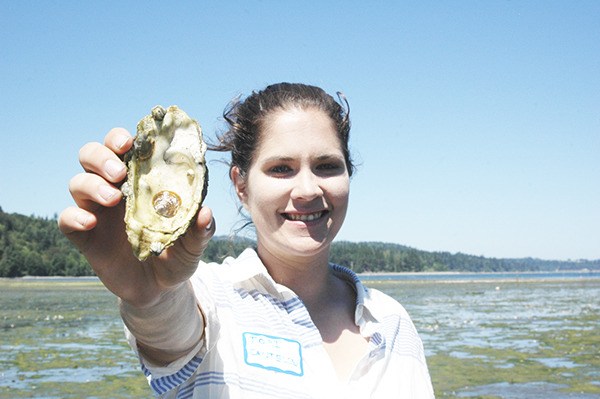Given the signs of success, county and tribal officials partnering in an ongoing effort to restore Olympia oyster populations within Sequim Bay are shifting their focus to monitoring the growth and survival of their previous work.
“We’re finding that Olympia oysters do really well in Sequim Bay,” Victoria Cantelow, Olympia oyster intern and project manager with the Clallam Marine Resources Committee, said. “The goal is to have a self-sustaining population.”
Benefits of work
As the native oyster of Washington, Olympia oysters once were abundant, but over-harvesting, disruption of habitat and importing of Pacific oysters and in doing so introducing other invasive species, nearly collapsed the population by the 1950s.
Olympia oysters may be smaller and slower growing in comparison to Pacific oysters and thus don’t compete with Pacific oysters among commercial and recreational markets, but the ecological benefits provided by the the presence of the native species are driving the restoration work.
“There are great ecological benefits to having these oysters return to where they once were,” Ralph Riccio, shellfish biologist for Jamestown S’Klallam Tribe, said.
For example, many micro-organisms and forage fish are associated with natural oyster beds and “we’re just trying to give Olympia oysters a shot at creating a self-sustaining population and natural beds again,” he said.
Unlike Pacific oysters widely sought for harvest, if Olympia oysters can continue to get established, they would be left to provide habitat and a method to filter biotoxins within the bay.
“I’ve heard oysters beds referred to as our coral reefs,” Cantelow said. “Not as pretty to some people, but by having these you have refuge areas and increased feeding opportunities for juvenile fish with all the organisms living within the beds.”
Research continues
To allow the Clallam County Marine Resources Committee to continue to collaborate with the tribe on the restoration project, Clallam County commissioners unanimously approved the agreement with the Jamestown S’Klallam Tribe on June 30.
Since 2012 and the initial effort to increase the presence of Olympia oysters in Sequim Bay, an area that historically supported a healthy population, seeded cultch totaling more than 700,000 individuals have been spread within 1.5 acres of tribal tidelands.
Because last year’s surveys reflected little mortality beyond the expected initial mortality, and instead natural spawning and an increasing presence Olympia oyster beds, Cantelow said it was determined to not bring in more seed, but provide more substrate, such as shells, also referred to as cultch.
“It seems to be the right zone,” Riccio said. “They like it here and there’s enough Olympia oyster larvae in the water column now to actually make it so that they’re spreading, which is very exciting.”
Given mid-June through August is the typical spawning season of Olympia oysters, plans to monitor in Sequim Bay are ramping up, Cantelow said.
“It will be interesting this year because if temperatures stay higher, it probably will be a longer spawning period,” she said.
Projects
In addition to conducting population and spawning surveys, new projects include the use of spawning pools in an effort to increase the rate of spawning and potentially seed surrounding cultch.
“We want to see if we made some sort of pool that would stay stationary out in the tidelands and warms up as the sun hits to initiate spawning in the pool filled with a bunch of cultch, if those those babies would develop and be released right onto the cultch because it’s going to be restricted water flow as well,” Riccio said. “It will be a while before we know if they did actually set.”
Additionally, shell strings (stacks of Pacific oyster shells on a wood dowel used collect Olympia oyster larvae) have been placed in three different areas within Sequim Bay for predetermined periods. Once removed, the shell strings will be used to study Olympia oyster larvae population and exchange within the bay.
Half the shell strings will be collected in August and the others collected next year to assess survival through the winter, Cantelow said.
In collaboration with partners, including officials with the Puget Sound Restoration Fund and the University of Washington also working on restoring Olympia oysters throughout the Strait of Juan de Fuca and Puget Sound, nearly 300 Olympia oysters were gathered from Sequim Bay to try to collect trace minerals specific to that area. The trace minerals found within the structure of the shell that’s created during the brooding phase of Olympia oyster development have a unique signature, Riccio said.
“We want to understand the connectivity between the oysters spawning in Sequim Bay and populations in other areas,” he said.
As work to restore native oyster populations proves to be successful in Sequim Bay, the Clallam Marine Resources Committee is looking for new areas to expand the effort.
“We hope to do test sites of Olympia oysters within Washington Harbor because it’s another area identified as historically containing populations,” Cantelow said.
If feasible, restoration work in Washington Harbor could add another 1-2 acres of tidelands for potential Olympia oyster beds in Clallam County.


